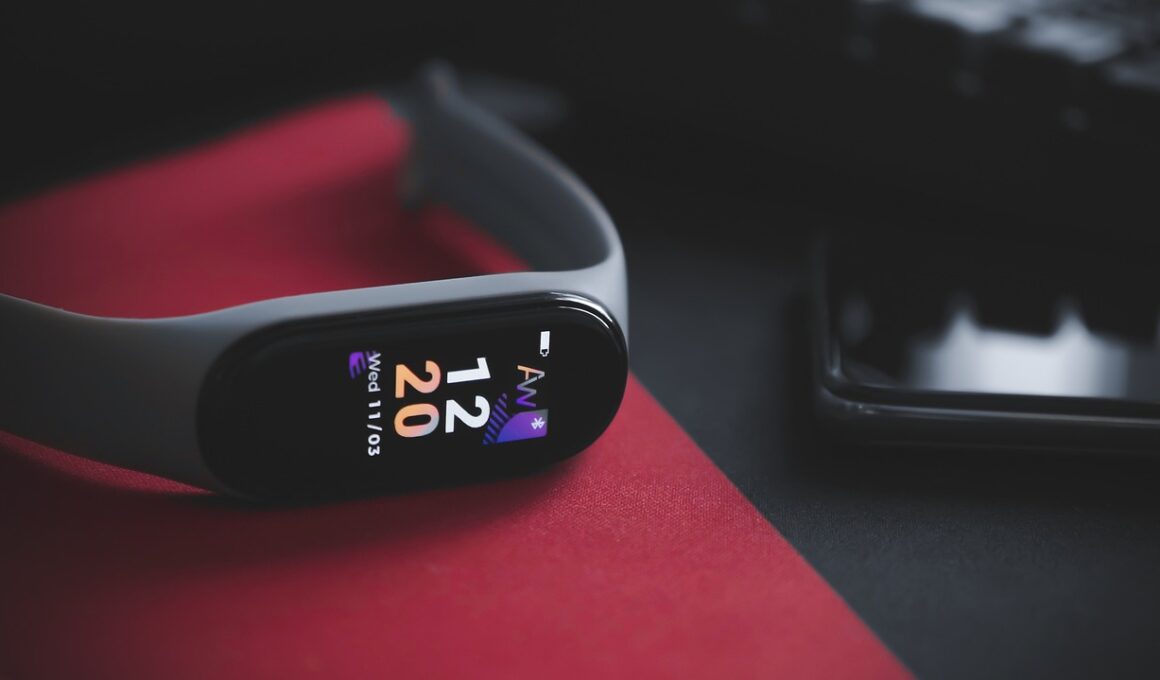How Wearable Heart Rate Data Influences Personalized Workout Plans
In recent years, wearable heart rate monitors have grown immensely in popularity, providing users with valuable data regarding their cardiovascular fitness. By consistently tracking heart rate during workouts, users can gain insights that promote effective training. This technology enables individuals to adjust exercise intensity based on heart rate zones, optimizing cardiovascular benefits. Individuals can establish specific targets correlating with their fitness goals, such as fat burning or endurance enhancement. Continuous heart rate data helps users recognize when to push themselves to maximum effort or slow down for recovery. This personalized approach not only improves workout efficiency but also minimizes the risk of overtraining, a common issue among fitness enthusiasts. Research indicates that understanding heart rate variations can significantly impact performance outcomes. For example, an athlete can tailor their regimen to ensure they are training within optimal heart rate ranges to enhance endurance or increase overall efficiency. Moreover, sharing this data with fitness professionals can facilitate customized plans further, aligning with personal fitness aspirations. Indeed, the implementation of wearable technology in fitness regimens fosters continual progress and elevated results across various fitness levels.
Wearable heart rate monitors offer real-time feedback that significantly influences workout performance. With features that collect and analyze heart rate data, they can inform users if they are training too hard or not hard enough. Adjusting workouts based on this information enables athletes to maintain optimal intensity and efficacy. The usability of these devices has also improved, making them accessible for individuals at all fitness levels. For example, a beginner might use heart rate data to gauge their progress and performance, while seasoned athletes can focus on fine-tuning their training habits. Users can also employ specific metrics, such as Resting Heart Rate (RHR) and Heart Rate Variability (HRV), to assess recovery and overall fitness trends. Understanding how these factors correlate to each individual’s unique physiology is crucial for maximizing workout effectiveness. Ultimately, using wearable heart rate monitors can encourage individuals to maintain a consistent workout routine, leading to improved cardiovascular health over time. This technology not only tracks heart rate but also motivates users to stay engaged in their fitness journey. As the industry continues to evolve, these wearables will likely become integrated into mainstream fitness practices.
Understanding Heart Rate Zones
To optimize workouts, it’s vital to comprehend heart rate zones and their significance for fitness routines. The five primary zones they fall into are: Resting, Fat Burn, Cardio, Anaerobic, and Max. Knowing these zones allows for tailored training sessions that target specific fitness goals. For example, exercising in the Fat Burn zone emphasizes burning stored fat whereas the Cardio zone focuses on enhancing aerobic capacity. As wearables track real-time data, users can effectively transition through these zones during workouts, maximizing their training effectiveness. For instance, during a HIIT session, individuals can alternate between the Anaerobic and Cardio zones, leveraging bursts of intensity for improved conditioning. Wearables display heart rate changes, prompting users to adjust their efforts dynamically. By integrating these insights into personalized plans, users can efficiently progress toward their desired outcomes. Furthermore, understanding recovery’s importance in relation to heart rate zones ensures they’re not overextending themselves. Thus, users can make the most of their workouts while prioritizing sustainable improvements in fitness levels. Hiring a personal trainer can enhance the effectiveness of a heart rate-based routine, ensuring a well-rounded approach to achieving fitness goals.
Wearable heart rate monitors provide valuable health data beyond workouts. They can track long-term trends, highlighting changes in heart health over time. Users can see how their heart rate responds to various stressors and recovery periods, allowing for improved training strategies. Moreover, they can determine when to incorporate rest days or low-intensive workouts, minimizing the risk of burnout or injury. This data informs users about their overall well-being, beyond just fitness. For example, elevated heart rates during sleep may indicate underlying stress or improper recovery. Thus, individuals can take proactive steps to manage their cardiovascular fitness effectively. Tracking emotional cues alongside training data emulates a holistic understanding of personal health. Furthermore, the integration of these devices with fitness apps enhances insights, creating a comprehensive view of wellness. Users can set realistic goals based on heart rate statistics and real-time feedback. By having access to detailed metrics, they can make informed decisions about their physical health journey. Consistent monitoring allows individuals to embrace better habits and cultivate an active lifestyle. In time, these practices lead to sustained improvements in cardiovascular health and overall endurance.
The Role of Feedback in Training
Wearable heart rate monitors also deliver essential feedback that shapes training and development. Such feedback allows users to take immediate actions based on data collected throughout their workouts. When a user’s heart rate exceeds their pre-set maximum during a workout, they can instantaneously dial back their effort to avoid potential injuries or fatigue. This continuous feedback loop empowers athletes to understand their limits and adjust their push accordingly. Additionally, having access to metrics such as heart rate averages, maximums, and recovery rates encourages users to set measurable targets for themselves. Setting benchmarks based on these metrics can promote motivation and accountability in one’s fitness routine. Notably, many devices provide post-exercise summaries, allowing users to reflect on their efforts and progress. This insight is essential for adapting future workout plans for further improvement. Ultimately, the combination of technology and user engagement leads to a more effective approach toward achieving personal fitness goals. Successful integration of wearable technology promotes ongoing progress in cardiovascular health and fitness. Ongoing advancements will undoubtedly further enhance the capabilities of these devices, enriching user experiences in future workouts.
As personalized workout plans evolve, integrating wearable heart rate data enhances effectiveness. For instance, based on the collected heart rate information, fitness professionals can design specific regimens tailored to individual needs. This collaboration between the user and trainer transforms generic plans into focused strategies that cater to personal aspirations. Furthermore, heart rate data can streamline goal setting, helping users establish reasonable fitness objectives. Rather than adopting a one-size-fits-all approach, programs can be adjusted based on physiological responses to exercise. Over time, implementing this data-driven strategy helps optimize workouts and improve endurance and overall fitness levels. Wearable technology encourages individuals to actively participate in their training. Consultation with professionals while using this data becomes profound in achieving meaningful health changes. Establishing a rapport with trainers, based on heart rate analytics, fosters a deeper understanding of one’s capabilities, ensuring athletes are challenged while remaining safe. Moreover, analyzing progress becomes easier, motivating users to commit to their plans and achieve new milestones. This synergy between technology and personalized training exemplifies the promising future of fitness as it harnesses innovative solutions to promote health and wellness.
The Future of Wearable Heart Rate Technology
The landscape of wearable heart rate technology continues to rapidly evolve, introducing features that enhance personalization and fitness experiences. Future advancements could integrate more comprehensive health metrics like sleep quality and stress levels, further contextualizing heart rate data. This fusion allows users to have an even deeper understanding of their cardiovascular health, fueling insights that can refine workout plans. Innovations may lead to increasingly accurate heart rate measurements, enhancing the reliability of data tracked during physical activities. Users will expect wearable devices to sync effortlessly with various fitness apps and platforms, providing multi-dimensional insights that motivate lifestyle changes. In addition, incorporating AI algorithms could lead to smarter coaching techniques, producing tailored suggestions for optimal training sessions. This revolutionary approach to personal fitness will cater specifically to each user’s metabolic rates, heart health, and fitness levels. The influence of social sharing features cannot be understated; users will likely seek community engagement, sharing achievements based on personalized heart rate data. As the possibilities continue to grow, the future of wearables presents a remarkable opportunity for helping individuals achieve their fitness aspirations and maintain long-term health.
In conclusion, the impact of wearable heart rate monitors on personalized workout plans cannot be overstated. These devices transform the way individuals approach fitness by providing real-time data that informs every aspect of their training. Understanding heart rate zones allows users to fine-tune their exercise intensity, enhancing the effectiveness of their workouts. Continuous feedback promotes adjustments and improvements in training intensity, ultimately fostering better cardiovascular health. Overall, incorporating heart rate data fosters accountability, encouraging individuals to take ownership of their fitness journeys. Working alongside personal trainers who analyze this data leads to individualized plans that cater directly to personal goals. The future looks bright for wearable heart rate monitors as technology continues to enhance personalization in fitness. As individuals embrace data-driven approaches, they pave the way for sustainable health improvements and long-term commitment to physical activity. The journey of integrating this innovative technology into fitness regimens is evolving but promises to result in stronger and healthier individuals who are engaged in their pursuit of cardiovascular wellbeing and overall fitness excellence. Embracing wearable heart rate monitor benefits signals a vital transformation in modern fitness approaches, allowing users to achieve their goals efficiently.


